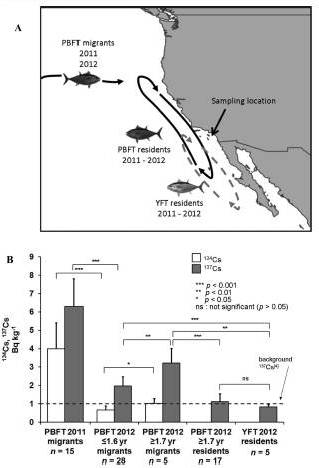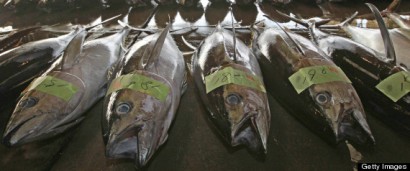
Radioactive Fish Found In California: Contamination From Fukushima Disaster Still Lingers
いまだに福島災害からの放射性物質が消えないカリフォルニアの魚
Posted: 02/22/2013 4:59 pm EST | Updated: 02/23/2013 12:15 pm EST
Aaron Sankin aaron.sankin@huffingtonpost.com
Nearly two years after a powerful earthquake triggered a leak at Japan's Fukushima Dai-ichi nuclear plant, the effects of that disaster are still being felt on the other side of the planet.
福島第一原発の放射能漏れの引き金となった巨大地震から2年近く経ち、その災害の影響は、まだ地球の反対側でも感じられます。
A report released earlier this month by researchers at Stanford University's Hopkins Marine Station found that bluefin tuna caught just off the California coast tested positive for radiationstemming from the incident.
スタンフォード大学のホプキンズ海洋研究室では、カリフォルニア海岸沖で取れたクロマグロに事故からの放射能を検出しました。

The study looked at the levels of radiocesium, one of the most common results of nuclear fission reactions, in Pacific Bluefun Tuna--largely as way to track the species' migratory patterns as the fish make their cross-oceanic journey in search of prey.
その研究は、核分裂反応の結果として最も一般的な放射性セシウムのレベルを、クロマグロの体中に調べたものです。それは、獲物を探して海を渡る種の回遊パターンを追跡する主な方法です。
While the report notes that the levels present in the fish are well below what public health officials would deem dangerous, the presence of radiocesium from the damaged reactor shows just how far-reaching the disaster's effects have been.
その報告によると、魚の放射能レベルは公共衛生局が危険だとするレベルを下回っているとしていますが、損傷した原子炉からの放射性セシウムの存在は、災害の影響がどれだけ遠くまで広がったのかを示しています。
Daniel Madigan, one of the study's authors, explained that this study shouldn't give people pause about eating tuna caught in the Pacific. "We're exposed to radiation in almost all of the food we eat," he explained.
この研究の著者の一人であるダニエル・Madigan氏は、自分たちの研究により太平洋で取れたマグロを食べるのをやめてしまうべきではない、と説明しました。「私たちは、ほとんど全ての食べ物から放射能に曝されています。」
"Cesium itself isn't safe, but the size dose that someone would get from eating this tuna would be," Madigan added, noting that the isotope has been present in Pacific marine life for decades as a result of mid-20th century nuclear testing.
「セシウムそのものは安全ではありません。しかし、このマグロを食べることからの放射能の量は大丈夫でしょう。」この核種が20世紀半ばの核実験の結果として、太平洋の海洋生物に何十年も存在してきていることに言及し、付け加えました。
Some 40 percent of bottom-feeding fish caught near the Fukushima plant tested positive for high levels of Cesium contamination, indicating that the plant still may be experiencing low-level leaks; however, most of those types of fish stick relatively near the Japanese coast and don't migrate all the way to the Americas.
福島原発付近で獲れる40%の海底魚の検査から、高いレベルを含めセシウム汚染が検出されています。それは、原発から低レベルの放射能漏れがまだあるかもしれないことを示唆しています。ほとんどのこれらのタイプの魚は、日本の海岸沿いに停留し、アメリカまでは移動しません。
While the Stanford study noted a drop in cesium levels in tuna caught off of the California coast, data collected by Japan's Ministry of Agriculture, Fisheries and Forestry indicate that a similar drop hasn't occurred in fish caught close to the plant.
スタンフォードの研究はカリフォルニア沖で獲れたマグロのセシウムのレベルが落ちたことを認めましたが、日本の農林水産省のデータは原発近くで獲れた魚にレベルの低下を示していません。
The Japanese government has banned both the domestic sale and international export of most fish caught close to the Fukushima coast.
日本政府は、福島の海岸の近くで獲れた魚を国内、海外に輸出することを禁じています。
This study is a follow-up to similar one conducted by Hopkins in 2011. The authors wanted to look at whether the radiocesium levels found in the tuna would increase or decrease for their previous examination. Comparing their results to data collected in 2011, the authors discovered that the most recent levels saw a very significant drop in Bluefin caught near California.
この研究は、2011年にホプキン研究室で同様になされた研究に続くものです。その研究の著者たちは、マグロに見られた放射性セシウムのレベルが前の検査よりも増加するのか減少するのかを見たかったのです。2011年に集められたデータの結果と比べると、カリフォルニアで獲れたマグロの最も最近のレベルが著しく低下していることが確認されました。

Interestingly, this radioactive contamination may ultimately prove to be a boon to the species. A study published earlier this year found that overfishing of the species, which is popular ingredient at Japanese sushi restaurants, has resulted in a 96 percent population reduction from previous levels.
興味深いことに、この放射能汚染が結局はクロマグロにとっての恩恵となるかもしれません。今年の初めに発表された研究から、すし屋で人気の食材であるこの種の魚の乱獲が原因で、前年生息量の96%になっていたことが分かったのです。
"Bluefin is seriously overfished," Madigan explained. "So having tools to track their migration is important in protecting them."
「クロマグロの乱獲は深刻です。」とMadigan氏は説明します。「なので、クロマグロの回遊を追跡する手段があることが、保護するのにとても重要なのです。」
Additionally, as Forbes notes, the perception that bluefin tuna are contaminated with radiation may lead more restaurants shying away from serving the fish, which would likely go a long way tamping down on the overfishing of a species that can often fetch a pretty penny.
さらに、Forbes誌は、クロマグロが放射能で汚染されているのいう見解が、レストランに魚を提供することを敬遠させるかもしれず、大金を得ることのできるクロマグロの乱獲を押さえ込むことに成功するかもしれない、と言及しています。

In January, a nearly 500 pound bluefin tuna sold for a record $1.76 million in an auction at Tokyo's famous Tsukiji Fish Market.
1月にほぼ500ポンド(227kg)のクロマグロが、有名な東京の築地市場のセリで記録の176万ドル(1億5000万円)で売られたのです。

Tuna study hints Fukushima plant still emits radiation
マグロ研究が示す福島原発の今尚続く放射能放出
by Charlie Smith on Feb 21, 2013 at 7:09 pm
For years, Health Canada has been recommending limits on the amount of tuna people should eat to avoid mercury poisoning.
何年もヘルスカナダは有毒な水銀を避けるためにマグロの摂取量を制限するよう勧めてきました。
The general advice is to consume no more than 150 grams per week of either tuna, shark, swordfish, escolar, marlin, or orange roughy.
一般的に、1週間に150グラム以上のマグロ、サメ、メカジキ、クロタチカマス、カジキマグロ、ヒウチダイを摂取しないように忠告しています。
However as the Straight has previously reported, Health Canada has not gotten too worked up about radiation levels in tuna as a result of the Fukushima nuclear accident.
しかしながら、当誌が以前に報告したように、ヘルスカナダは、福島原発事故の結果としてのマグロの放射能レベルについてはまとめていません。
This is in spite of a recent article on the Forbes website about a Pacific bluefin tuna study. It hints that radiation may still be spewing from the damaged Fukushima nuclear reactors into the Pacific Ocean.
最近のForbes誌のウェブサイトに掲載された、太平洋のクロマグロについて研究の記事にも関わらずです。それは損傷した福島の原子炉から、まだ放射能が海に放出されているかもしれないとほのめかすものです。

Forbes staff writer Monte Burke notes the study's conclusion that tuna excrete radiation from muscle tissue as they swim to California.
Forbes誌の記者Monte Burke氏は、マグロがカリフォルニアへ回遊してくる際に、筋肉細胞から放射能の排出しているのだという、その研究の結論に言及しています。
Here's what's disturbing: these migratory fish continue showing up with radiation in their bodies after crossing the ocean.
不穏なのは---これらの回遊魚が海を渡った後でもまだ体内に放射能をとどめて現れ続けている、ということです。
"That means, ultimately, that there is still a high level of radiation in the waters near the Fukushima plant most likely because, as marine chemist, Ken Buessler, asserts, the plant is still leaking radiation into the ocean nearly two years later," Burke writes.
「それは結局、今でも福島原発近くの海水に、高レベルの放射能がある、ということを意味し、海洋化学者としてケン・Buessler氏は、2年経った後でも、原発からは放射能が海に漏れ続けているからに違いないと主張している。」とBurke氏は書いています。
No comments:
Post a Comment